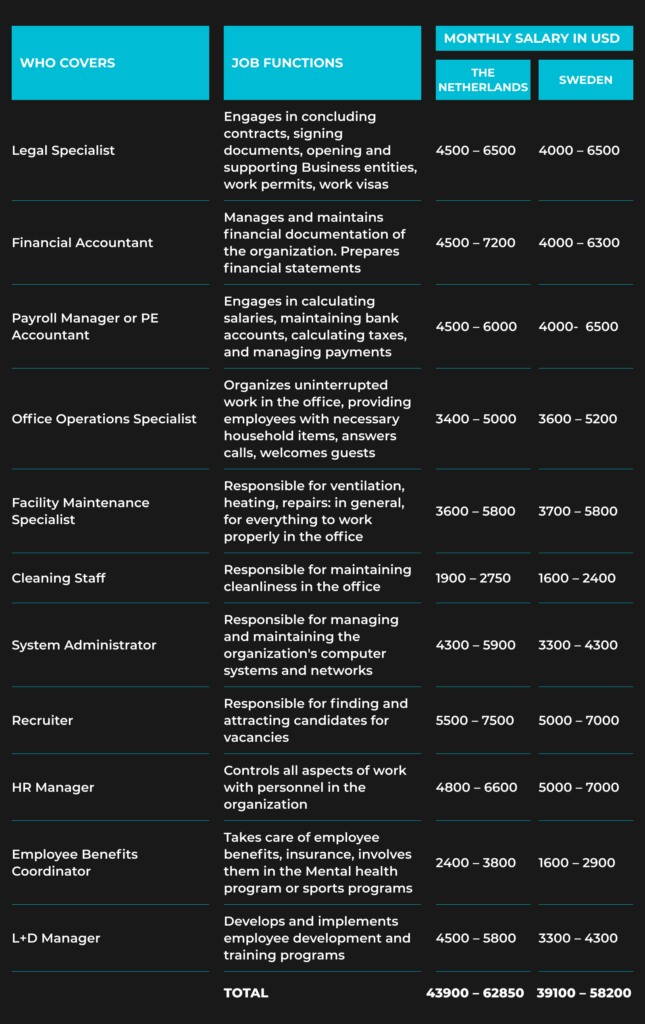Caffeine Economics Part 5: Staff Augmentation vs. In-house Teams in Northwestern Europe
Businesses today are met with a crucial challenge — forming the right team to make their visions a reality. While traditional in-house hiring has advantages, the continuous talent shortage has sparked a growing interest in alternative solutions like staff augmentation.

This exact challenge is what Alice, a dynamic 40-year-old CEO of an IT company in Stockholm, encounters.
Alice has led her team to develop an innovative FinTech platform tailored to the demanding B2B market for six years. With branches in Stockholm and Amsterdam, her company employs 21 professionals, including a robust team of 13 developers. As her business experiences steady growth, Alice faces a pivotal moment due to the increasing demands of her back-office operations. She needs a strategic approach to hiring for the next phase of her company’s growth.
Managing In-house Developers Effectively Can Be Challenging
Alice and Andrew, the experienced 47-year-old COO of an IT company in Toronto, have been acquainted for several years. They first met at a tech conference, where they bonded over a mutual enthusiasm for innovation and business consulting. Since that meeting, they’ve stayed in touch, frequently sharing insights and brainstorming ideas via video calls.

On one occasion, over coffee, Andrew shared with Alice how IT staff augmentation had enhanced his company’s efficiency and cut costs. This was like the proverbial eureka moment for Alice. She realized that effectively managing in-house talents, with their diverse skill set and personalities, was a significant challenge. The hassles are never-ending, from talent recruitment, acquisition, and retention to skill development, team dynamics, resource allocation, legal and compliance issues, work-life balance, and employee turnover.
Andrew’s success with staff augmentation, which offered access to better-qualified employees, improved productivity, and cost savings, could be the key to the next phase of her company’s growth.
But first, Alice needed to crunch numbers first, calculating the expenses of running her in-house team.
Here is what she uncovered:
*Our team calculated the average salaries of key people of the operational team, without whom the functioning of the business becomes difficult. Also, there are a number of services, such as insurance or renting an office, which also fall on the shoulders of the business owner, but we did not count them, because the costs can vary greatly depending on the quality of these services.

Compensation and Benefits
Alice discovered that compensation and benefits for her in-house talents weigh heavily on her company’s budget. To thrive in the fiercely competitive IT job market, she has to offer attractive salaries that would not only draw top-tier talent but also retain them. But it doesn’t end there. Apart from the base salary, Alice has to consider additional expenses like overtime payment, bonuses, housing allowance, transportation allowance, and meal allowance, which impact the company’s profit margins.
Legal Services
Managing an in-house team also means grappling with complex legal considerations, including employment contracting and document signing, business entity opening and support, work permission, and work visa (where applicable). Alice knew she had two options: maintain an in-house legal team or engage external legal counsel. Either way, legal fees, consultancy, and the costs of this process quickly pile up.
Finance & Payroll
To effectively manage finances and payroll for her in-house team is a multifaceted task. It involves employing financial professionals to handle labor payroll processing, bank account opening and management, tax calculation, and payment management, as well as ensuring compliance with tax laws and employment regulations. This ongoing operational expense also encompassed software and tools necessary for efficient financial management.
Workplace Management
Workplace Management added a substantial financial dimension to her considerations. Providing office space for her in-house back-office personnel, especially in prime locations like Stockholm and Amsterdam, comes with steep rents, utility bills, and maintenance expenses. Furthermore, travel and visa support (where needed), procurement, and delivery add to the expenses.
On top of that, there are costs related to furnishing the workspace, setting up IT infrastructure, and ensuring a conducive environment for productivity. These ongoing workplace management expenses could significantly affect the company’s profitability, especially as growth and expansion demanded accommodations for a larger team.
Equipment Management
Outfitting each back-office staff is a continuous financial commitment. The cost of purchasing and delivering equipment kits, IT infrastructure setup and maintenance, software and hardware installation, regular equipment upgrades, security, network and servers maintenance, tech labs building, and other technology resources can quickly escalate, particularly as technology evolves. Ensuring everyone has access to the latest and most efficient tools is essential for productivity but can strain the IT budget over time.
Talent Management
Talent management isn’t just about hiring people; it involves an entire ecosystem of expenses. To attract top-tier talent, Alice’s company has to invest in various recruitment efforts, including recruitment agencies, job listings on multiple platforms, and rigorous interview processes. These activities required both time and financial resources. Furthermore, talent onboarding, performance review, evaluation, recommendation, daily support and communication, time off management, services policies development, and sharing are essential to ensure her team stays competitive in the ever-evolving tech landscape. The goal is to nurture and retain talent, but it comes with a substantial price tag that cannot be overlooked.
Team Benefits
In addition to basic salaries, providing comprehensive team benefits is vital. Premium medical insurance, mental health program, football team, special-occasion leaves, in-office snacks, and other perks are part of the package to enhance the job satisfaction of her workers. Let’s not forget the coffee. Employees tend to consume liters of the stuff, and of course, Alice cannot implement a bring-your-own coffee policy. The cost per cup quickly adds up. These benefits represented a significant portion of the company’s expenses, and the costs associated with maintaining them must be factored into the budget.
Retention & Engagement
Employee retention and engagement is an ongoing challenge that demands financial investments. Alice recognizes the importance of keeping her in-house back-office team motivated and satisfied to reduce turnover and maintain a cohesive and productive team. This means investing in team-building activities, incentives like welcome kit delivery, birthday gifts/anniversary gifts, corporate activities, CSR, and employee recognition programs. While these initiatives are crucial for fostering a positive work environment, they add to the company’s operational costs.
Operating SaaS
The tech industry relies heavily on software-as-a-service (SaaS) tools and platforms for development, collaboration, and project management. These tools, ERP, CRM, HCM, LMS, DMS, DS, and BIS, come with recurring costs, and the more tools her team uses, the higher the cumulative expense. While SaaS solutions offer convenience and efficiency for back-office team members, they also contribute to the financial burden of managing an in-house team.
Development
Development-related expenses go beyond just workers’ salaries. They encompass the costs of hardware, software licenses, development tools, and the necessary infrastructure. Let’s not forget the place of personal and career development — training and certification, language courses, and educational events. Staying at the forefront of technology required consistent investments to ensure her team had access to the latest and most efficient resources.
As Alice delved deeper into her financial analysis, sipping her second cup of coffee, she realized that her in-house team’s financial demands were more intricate and extensive than she initially thought.
The collective burden of these expenditures, coupled with the intricacies of personnel management and the scarcity of highly skilled local talents, prompted her to seriously explore the advantages of staff augmentation meaning access to a diverse talent pool in a jurisdiction with lower taxation levels.

Remember, Andrew had introduced this managed services model to her in their last conversation — the idea of offloading all the back-office administrative concerns onto capable shoulders elsewhere.
This innovative model promised to grant her access to a broader and more highly qualified talent pool, potentially leading to improved productivity, less pressure on Alice and reduced overall operating costs. It was a path that was becoming increasingly appealing to Alice, particularly in light of the intricate financial challenges associated with managing an in-house team.
Overcoming the Challenges with Effective IT Staff Augmentation Solutions
As interesting as Alice’s story is, this scenario is faced by virtually every IT leader in today’s dynamic tech landscape. From Stockholm to Rotterdam, Amsterdam, Hague, New York, and even London, tech enterprises face a downward slope of qualified local IT talents, many challenges managing existing teams, and an upward slope of operating expenses. These situations underscore the importance of IT staff augmentation services.
But if you’re in Alice’s shoes and opt to jump on the outsourcing trend, how can you effectively track performance, manage the team, and ensure that the remote work is done efficiently?
Here are some quick tips:
- Define Clear Expectations and Objectives: Establish clear and specific performance expectations, including project goals, deliverables, and deadlines. Ensure that all team members understand their roles and responsibilities.
- Use Key Performance Indicators (KPIs): Define relevant KPIs that align with project and business objectives. KPIs can include metrics like customer satisfaction score, case complete rate, case quality score, accuracy rate, compliance score, and turnaround time.
- Regular Communication: Create a well-defined communication plan, including regular team meetings, one-on-one check-ins, and consistent status updates. Leverage video conferencing, chat platforms, and collaborative tools to streamline communication.
- Performance Feedback: Provide constructive feedback regularly to help team members improve their performance. Recognize and reward outstanding contributions to boost motivation.
- Security and Data Protection: Implement security measures to protect sensitive data and ensure compliance with data protection regulations. Educate team members about security best practices for remote work.
- Work with a Reliable Service Provider: Working with a reliable staff augmentation services company can significantly enhance the success of your staff augmentation efforts by providing access to a pool of qualified talent and valuable guidance throughout the engagement.
For example, here at Newxel, we not only facilitate access to highly skilled talents from across the globe for your back-office needs but also provide comprehensive support across the entire project lifecycle. Our teams can handle every aspect of your back-office roles seamlessly and efficiently, allowing you to focus on other critical aspects of your operations.
Be Like Alice – Focus On Development
Running a software development team doesn’t have to be a constant uphill battle. While there are undoubtedly pros and cons to any staffing method, the sheer pressure and intricacies of managing an in-house back-office team can sometimes shadow your core mission — software development.
Alice realized that there was a more streamlined way to navigate this terrain. Just like her, you can leverage IT staff augmentation to lighten the load and regain your focus where it truly matters — on software development itself.
Rather than being bogged down by administrative intricacies, you can channel your energy into nurturing innovation, fostering creativity, and delivering outstanding software solutions to your clients. So, why get caught up in the complexities when you can be like Alice and set your development company on a path to thrive with IT staff augmentation?
When finding the best partner for staff augmentation in back-office roles, look no further than Newxel. With a proven track record of excellence and a commitment to delivering top-tier talent, Newxel can help you unlock more time, resources, and innovation potential by handing over your back-office tasks to a trusted and qualified remote team.





